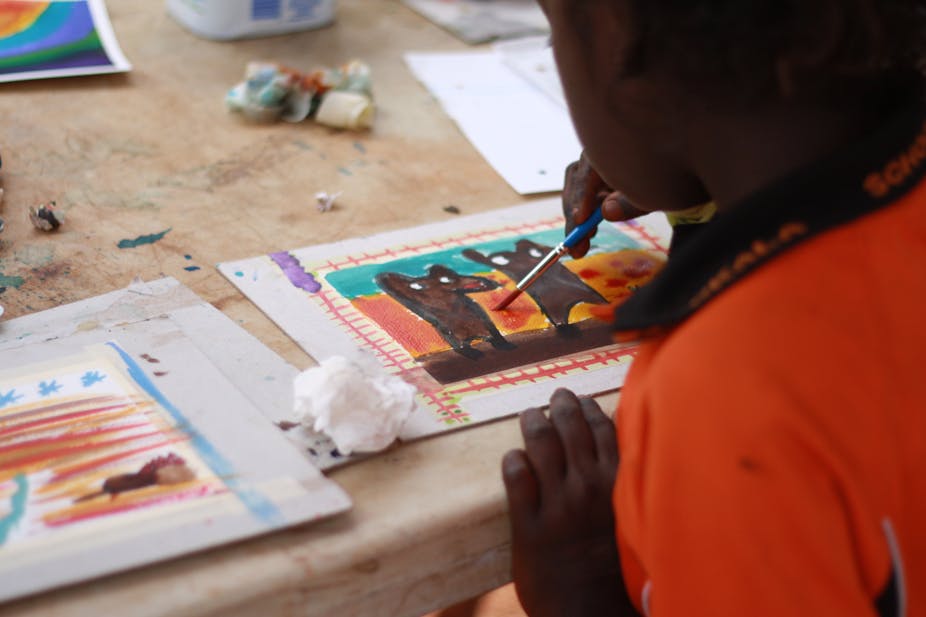Indigenous education has been prioritised by Prime Minister Tony Abbott and the states at the recent COAG meeting. The focus is on truancy, with a school attendance target of 90-100%. “Punitive” measures have been suggested, including truancy officers and extending income management.
But punitive measures are unlikely to affect Indigenous education outcomes in any meaningful way because they don’t address the roots of the problem. More importantly, punitive measures are another attempt to remove the agency of Aboriginal people.
Education systems
Aboriginal children are disconnected from the mainstream education system for a number of complex reasons. There are barriers to their success, such as poor sleep if they live in an overcrowded home; hunger affecting children’s focus; a lack of Indigenous role models as teaching staff; and the fact that Indigenous culture is marginalised in mainstream schooling.
In families with no history of educational achievement, the culture of the education system needs to be learnt from scratch. Even if children are forced to attend school, there is no guarantee that they will learn what we want them to learn.
Many of the Aboriginal and Torres Strait Islander people I work with for my research extol the virtues of education. They agree with Abbott’s view that a good education is crucial to a good start in life. But for others, the education system represents a culture and a society that does not value them. In response, they do not value the education system.
Punitive measures are based on the idea that Aboriginal people cannot make choices for themselves. They continue the belief that white society is the standard to be lived up to, a standard that can only be achieved through the education system. Forcing people to take part in this will not encourage trust or educational success.
Making challenging choices
A central sociological debate is the structure versus agency debate. On one hand we have structure – the idea that our lives are determined by society. Race, gender, and socioeconomic status and the like are determinants in the opportunities available to us.
On the other side we have agency: the idea that individuals make choices and shape their own lives. Sociology has long focused on the structures that determine our lives.
But there is recent interest in the idea of agency. Importantly, recent theories discuss the relationship between structure and agency, recognising that while our lives are shaped by the systems around us, we also have some capacity to shape our worlds. When people feel like they have no control, they will find ways to make choices, often in ways most of us find unappealing.
Racism is one structure that constrains Aboriginal choices. For some people, ensuring their children receive a rigorous education is one way they choose to respond to this structure. But when people feel alienated by the education system, they are not likely to make this choice.
Aboriginal people in this situation are faced with a lack of alternatives. They can choose to participate in an education system that does not meet their needs, or to avoid it. We need to recognise this as one way that Aboriginal people choose to exercise their agency.
Young people in particular feel like the school system is not relevant to their lives, or they might have bad relationships with their teachers or fellow students. Coupled with the kinds of socioeconomic and cultural barriers discussed above, the reasons for not attending school will not go away, no matter how punitive the measures adopted.

Overcoming the barriers
If punitive measures won’t work, what is the solution? While truancy is a legitimate exercise of agency, education is also valuable in a number of ways.
One of the first steps, which should be taken immediately, is to break down the barriers to education. The challenges of overcrowding in Aboriginal communities, freedom from violence and regular access to healthy food are not likely to be resolved by income management or truancy officers.
Australia needs an education system that does more than pay lip service to Aboriginal culture and the history of colonisation in this country. Our education system should actively fight against stereotypes and racism. And, importantly, we need to recognise the cultural or practical barriers that Aboriginal children experience and do something about them.
Alternative styles of education deserve more research and more funding. For students who have disengaged, training programs that involve the community and “real life” settings are much more appropriate.
Alternatives like Free Schools, where students have options about what they will learn, and which deliver content through hands-on activities, might be more appropriate than traditional schooling. This was trialled in Townsville in the 1970s by Eddie Koiki Mabo and Harry Penrith. They established the Black Community School because they felt the education system was failing Aboriginal and Torres Strait Islander students.
All of these alternatives require us to trust Aboriginal agency – to acknowledge that the mainstream system doesn’t always know what is best for Aboriginal people.

